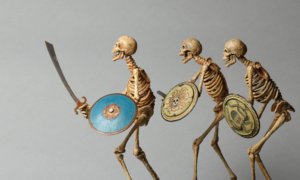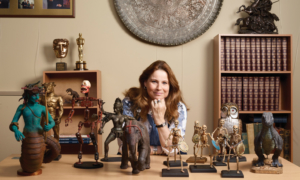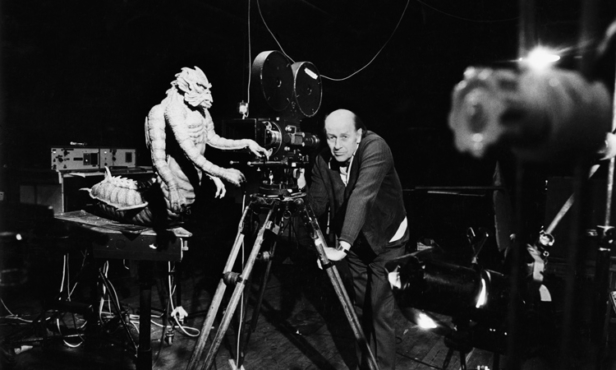As one of the most influential stop-motion animators, Ray Harryhausen’s career spanned decades, incorporating classics such as Jason And The Argonauts and Clash Of The Titans. His special effects are so seminal that, though his early films were made almost 60 years ago, they still hold up today. Harryhausen influenced countless artists after him and took special effects to a new level. His unique vision and memorable creations make the movies he worked on stand out – you always know when you’re watching a movie with a Harryhausen stamp on it.
On 29 June 2020, Harryhausen would have turned 100. To celebrate in our own SciFiNow way, we spoke to John Walsh who created a documentary about the visionary and who will be releasing a book about some of Harryhausen’s work that we never got to see in Harryhausen: The Lost Movies.
How did you first meet Ray Harryhausen?
I was at the end of my first year at the London Film School and I wanted to do a film about Ray Harryhausen. I actually found his phone number in a telephone directory! He answered the phone himself and I was quite surprised because I didn’t have much of a plan in place. Eventually I got to meet him at his house. He had an enormous house in Holland Park, two doors away from Jimmy Paige from Led Zeppelin. I said to him: “I want to make a little film about your life, about your work.” And so I did. I shot it on 16mm. It’s a 15-minute film and I managed to get Tom Baker to narrate it for free.

What do you think is the secret behind Ray Harryhausen’s timeless endurance?
Ray Harryhausen is a genre in itself. In the same way that Disney is a genre. His genre tends to create its own little time bubble. But the key thing is performance. Ray used to do performances through his fingers into his puppet creatures. Today, if you look at the big superhero films, thousands are involved in the intricate animation. But Ray acting through his fingers is one person acting. Sometimes that can be more engaging. Harryhausen is also unique because he didn’t facilitate for other people. The majority of his work he created for himself, by himself, often writing the stories, being the producer on the film and being the special effects guy. No one else so far in cinema history has done that.
For those new to Harryhausen, what do you recommend as a good starting point?
I think for younger people it’s best to start with the colour films and my favourite is The Golden Voyage Of Sinbad. For me that [film is a] golden moment where everything came together beautifully. You had the Bond girl Caroline Munry and the fabulous villain played by Tom Baker, who won the role of Doctor Who after appearing in it. Barry Letts, the producer of Doctor Who, was looking for a replacement for John Pertwee. He saw Tom playing Prince Koura [in The Golden Voyage Of Sinbad] and rang his agent that afternoon. A meeting was set up with the BBC and that week he was cast!
I put the screws on Tom Baker when I was making my film: “I know you won the role of Doctor Who because you were in The Golden Voyage Of Sinbad, will you voice my documentary for free please?!” Even now I’m embarrassed at the thought of even asking that but if you don’t ask you don’t get!

Can you tell us more about The Lost Movies Of Ray Harryhausen?
You might be surprised to find that Ray tried to get the rights to Conan in the early Seventies. At the time they were considered unfilmable because the studios thought the content was juvenile yet also very adult, so it would need an 18 certification and the teenagers who would want to see it wouldn’t be able to get in. That’s why that didn’t happen. When Conan was made in the early Eighties, it had a restricted certificate and it was very successful; a new genre of ultra-violent sword and sandal was born. Ray predicted that.
If we jump forward to the early-Eighties, Ray turned down the first Marvel feature film – X-Men, as written by Stan Lee, because he was busy doing other projects. He also turned down one of my favourite films of all time in 1984: he said no to David Lynch and Dune.
What do you think of the use of stop-motion animation today?
From a commercial point of view, there [have been] more hours of stop-motion made in the last three-four years than in any time when Ray was working. There’s virtually no practitioner of stop-motion that doesn’t claim Ray Harryhausen as the godfather of that genre. Ray lived long enough to see it. Tim Burton, when he came to London, would always call in to see Ray and share with him models from The Nightmare Before Christmas. Ray was thrilled to see that the technique isn’t extinct.

What is planned this year for Harryhausen’s centenary?
A big exhibition we had planned at the Scottish National Gallery, named ‘Ray Harryhausen: Titan of Cinema’, has been postponed, but we are going to be polling of all of Ray’s creatures, which will end up creating a new top ten that will be announced on the centenary. Vanessa Harryhausen has also written a book: Ray Harryhausen: Titan of Cinema which features 100 Harryhausen objects. It shows some of the images and behind the scenes stuff that hasn’t been seen before. We’ve also got some screenings and 4k premiers coming up. We’re going to be doing lots of new stuff!
Check out here who won the Ray Harryhausen favourite creature. Harryhausen: The Lost Movies by John Walsh is out now. Don’t forget to tune into the Ray Harryhausen panel today at the SDCC Comic Con @ Home.
